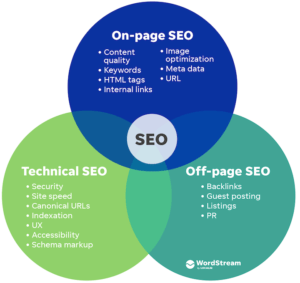Introduction
Firstly, it is insufficient to have a visually pleasing website with excellent content in the cutthroat world of online marketing. Additionally, in order for search engines to efficiently crawl, index, and comprehend your website, technical SEO is essential. Moreover, in this blog, we will dive into the realm of technical SEO, exploring the key concepts and techniques that can help you optimize your website for search engines and experience the best digital marketing course in Varanasi. Furthermore, from website speed and mobile-friendliness to URL structure and schema markup, we will provide a comprehensive guide that will empower you to enhance your website’s technical aspects and improve its visibility in search engine results.
On-Page SEO Vs Off-Page SEO Vs Technical SEO

Search engine optimization (SEO) is a multifaceted discipline, and its success hinges on the effective implementation of various strategies. Three primary pillars of SEO—on-page SEO, off-page SEO, and technical SEO—work in harmony to optimize a website’s performance and enhance its visibility on search engine results pages (SERPs). Let’s delve into the distinctions among these crucial components.
On-Page SEO:
On-page SEO in digital marketing revolves around optimizing the content and structure of a webpage to make it more appealing to both users and search engines. Key elements include:
- Keyword optimization is the deliberate use of pertinent keywords in headers, titles, and body text.
- Content quality is the assurance that the information is interesting, educational, and relevant to the intended audience.
- Meta Tags: Creating catchy meta descriptions and names that fairly convey the content of the page.
Off-Page SEO:
Off-page SEO involves activities outside the website that impact its search engine rankings. This often centers around building a website’s authority and credibility through external factors:
- Backlink Building: Acquiring high-quality backlinks from reputable websites to signal authority to search engines.
- Social Media Presence: Leveraging social media platforms to promote content and engage with a broader audience.
- Online Mentions and Reviews: Encouraging positive mentions and reviews on external sites to enhance the website’s reputation.
Technical SEO:
Technical SEO addresses the backend aspects of a website, focusing on its infrastructure and how search engines interact with it. Key considerations include:
- The speed of a website is important for both SEO and the user experience.
- Mobile-Friendliness: Optimizing the website for mobile devices to accommodate the growing number of mobile users.
- Crawlability and Indexability: Making sure search engine bots can easily crawl and index the site’s pages for accurate SERP rankings.
At DIDM, our experts will let you experience the best digital marketing course in Varanasi.
Key Differences:
Focus and scope:
- On-page SEO deals with the content and structure of individual web pages.
- Off-page SEO extends beyond the website to build its authority and credibility across the internet.
- Technical SEO addresses the backend and infrastructure of the website to ensure optimal performance.
Control:
- On-page SEO elements are largely within the website owner’s control.
- Off-page SEO involves external factors that the website owner can influence but not directly control.
- Technical SEO pertains to factors that require direct website management and optimization.
Impact on Rankings:
- On-page SEO influences the relevance and quality of content, impacting how well a page ranks for specific keywords.
- Off-page SEO contributes to the website’s overall authority and credibility, influencing its rankings across the site.
- Technical SEO ensures that the website is accessible and user-friendly, contributing to its overall search engine visibility.
Components of Technical SEO: Inside the Best Digital Marketing Course in Varanasi.
Understanding technical SEO:
Firstly, technical SEO is the practice of optimizing the technical aspects of a website, making it easier for search engines to crawl, index, and understand its content. Additionally, it involves various strategies and techniques that focus on site architecture, website speed, mobile friendliness, URL structure, metadata, structured data, and more. Moreover, a strong technical foundation is crucial to ensuring that search engines can effectively analyze and rank your website in search results.
Website speed optimization:
The speed of a website is important for both SEO and the user experience. Optimizing your website’s speed involves compressing large files, minimizing server response time, leveraging browser caching, and reducing the number of HTTP requests. By improving your website’s speed, you can enhance user engagement and decrease bounce rates, positively impacting your search engine rankings. For speed checking, you can use the G.T. Metrix tool.
Mobile-Friendly Design:
It is essential to have a mobile-friendly website because mobile devices are being used more and more.. Responsive design, fast mobile load times, and ensuring that content and features are easily accessible on mobile devices are key components of mobile optimization. Search engines prioritize mobile-friendly websites in their rankings, making this aspect crucial for both SEO and user experience.
URL structure optimization:
Additionally, search engines can better comprehend the hierarchy and content of your website with the aid of an optimized URL structure. Consequently, it involves creating descriptive, keyword-rich URLs, avoiding dynamic parameters, and using hyphens to separate words. As a result, optimized URLs improve the user experience and make it easier for search engines to crawl and index your website.
Metadata optimization:
Title tags, meta descriptions, and header tags (H1, H2, etc.) are essential elements of metadata optimization. Crafting unique, descriptive, and keyword-rich title tags and meta descriptions helps search engines understand the context and relevance of your web pages. Header tags provide structure and hierarchy to your content, making it easier for search engines to understand and rank your website.
Structured Data and Schema Markup:
Structured data, implemented through schema markup, helps search engines understand the content and attributes of your website more effectively. It provides additional context and makes your website eligible for rich snippets in search results, enhancing visibility and click-through rates. Implementing structured data correctly can greatly improve your website’s visibility and relevance in search engine rankings.
Site Architecture and XML Sitemaps:
Creating XML sitemaps aids search engines in crawling and indexing your website efficiently, enhancing its performance for all users.
Technical SEO Audits and Monitoring:
Further, regular technical SEO audits and monitoring play a crucial role in maintaining and improving your website’s performance in search engine rankings. In addition, audits help identify and fix technical issues such as broken links, duplicate content, crawl errors, and page speed problems. Additionally, monitoring your website’s performance allows you to stay updated on any technical issues that arise and take proactive measures to address them promptly.
To understand technical SEO in detail, you can pursue a digital marketing course From Best Digital Marketing Course in Varanasi.
Conclusion :
In the complex world of SEO, technical optimization is a crucial component for achieving higher search engine rankings and improving the user experience. Additionally, this comprehensive guide has explored various technical SEO aspects, including website speed optimization, mobile-friendly design, URL structure, metadata optimization, structured data, site architecture, and technical audits. By implementing these strategies effectively, you can ensure that your website is easily discoverable, accessible, and understandable by search engines. Consequently, this will ultimately lead to increased organic visibility, higher traffic, and improved user engagement.





